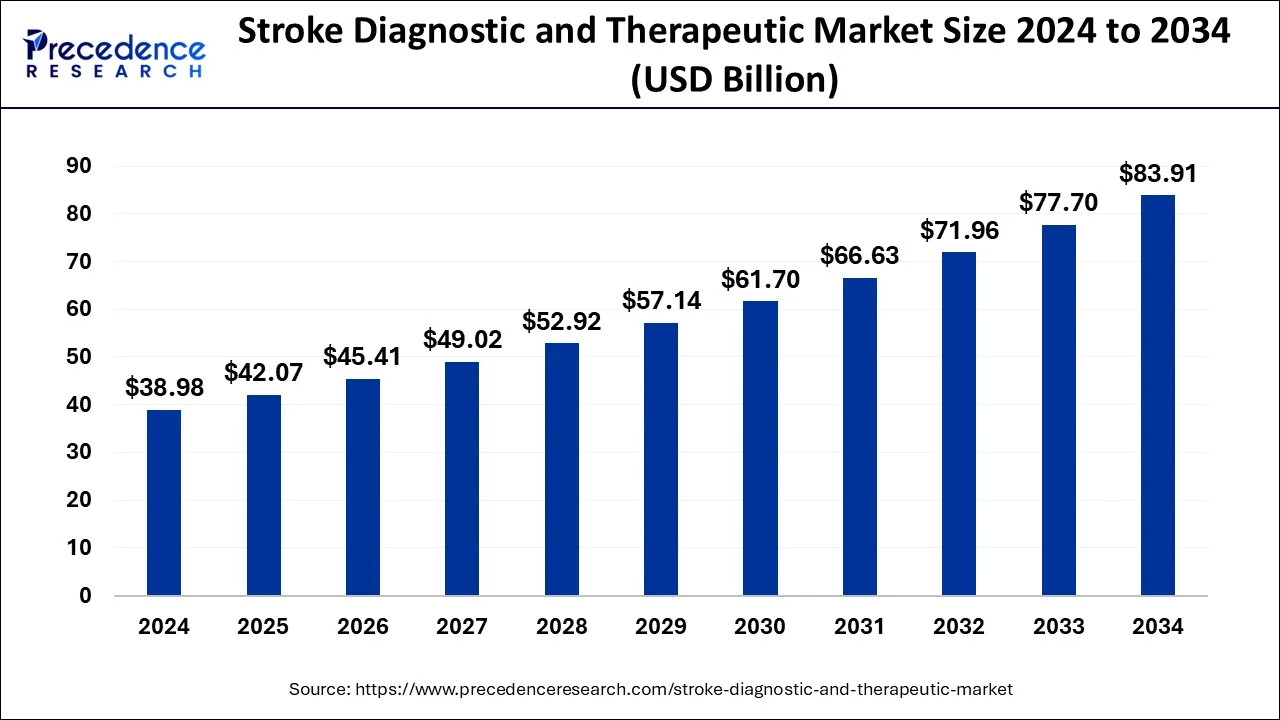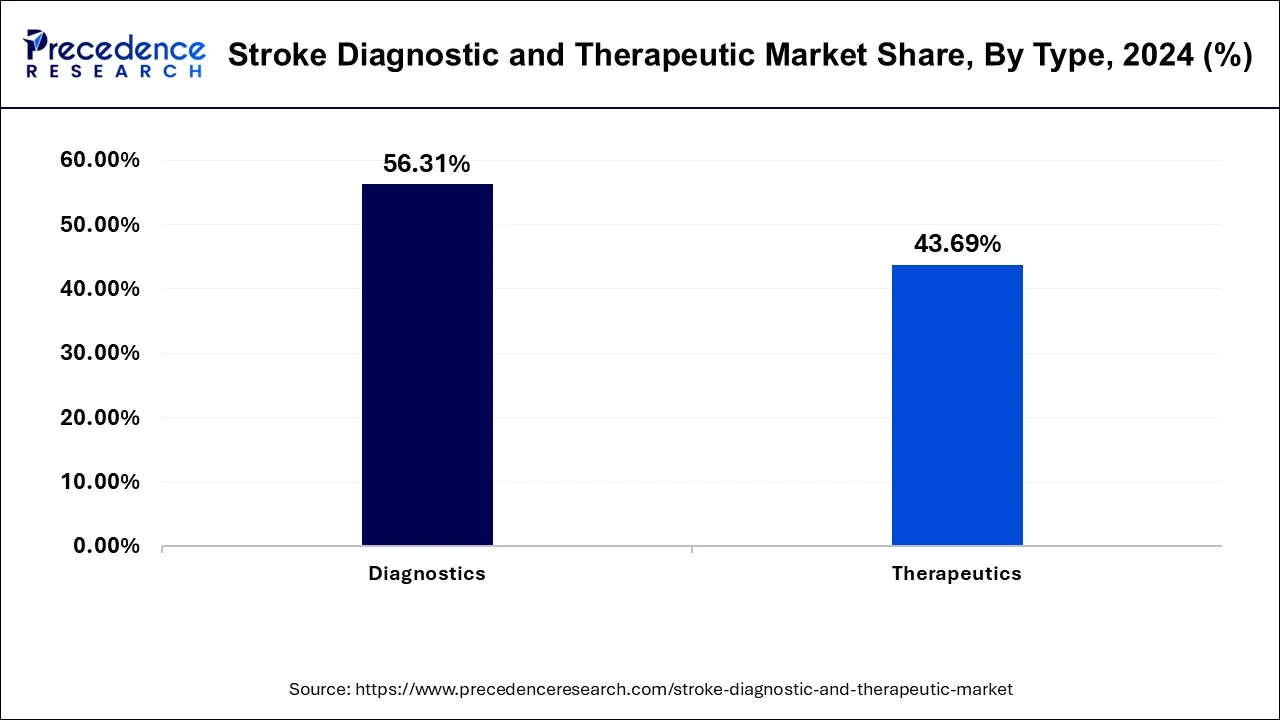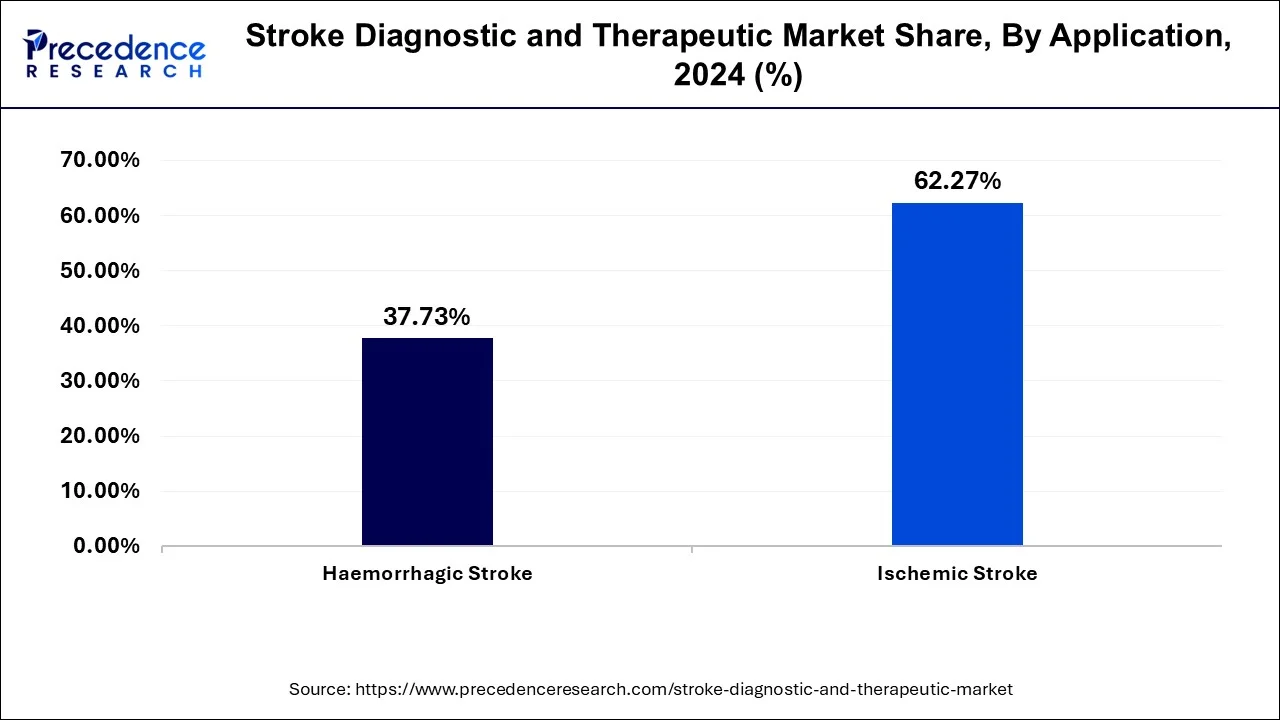List of Contents
Stroke Diagnostic and Therapeutic Market Size and Forecast 2025 to 2034
The global stroke diagnostic and therapeutic market size was estimated at USD 38.98 billion in 2024 and is anticipated to reach around USD 83.91 billion by 2034, expanding at a CAGR of 7.96% from 2025 to 2034. The rising prevalence of ischemic stroke among geriatric population has boosted the growth of the stroke diagnostic and therapeutic market.

Stroke Diagnostic and Therapeutic Market Key Takeaways
- North America dominated the stroke diagnostic and therapeutic market with the largest market share of 26.64% in 2024.
- Asia Pacific is expected to expand at the fastest CAGR of 8.8% during the forecast period.
- By type, the diagnostics segment contributed the highest market share of 56.31% in 2024.
- By type, the therapeutics segment is projected to grow at a notable CAGR of 7.8% during the forecast period.
- By application, the Ischemic stroke segment has held the biggest market share of 62.27% in 2024.
- By application, the hemorrhagic stroke segment is growing at a CAGR of 8.1% during the forecast period
Role of AI in Stroke Diagnostic and Therapeutic Market
Artificial Intelligence (AI) is changing the landscape of stroke diagnostics and therapeutics by providing clinicians with the ability to make quicker, more accurate, and data-driven clinical decisions. In therapeutic applications, AI is driving the design of innovative robotic rehabilitation systems enabling post-stroke therapy to be optimized and patient outcomes improved. In addition, the emergence of AI-enabled telemedicine may facilitate stroke care in rural or less resourced regions.
As demand continues for precision medicine, AI has the potential to reposition itself as a game-changer in the provision of stroke care. As health systems keep digitizing, the role of AI should expand significantly within the stroke care continuum with improvements in the accuracy of imaging and efficacy of treatment.
U.S. Stroke Diagnostic and Therapeutic Market Size and Growth 2025 to 2034
The U.S. stroke diagnostic and therapeutic market size was evaluated at USD 5.88 billion in 2024 and is predicted to be worth around USD 12.64 billion by 2034, rising at a CAGR of 8% from 2025 to 2034.

North America is Valued to be the Major Market for Stroke Diagnostic And Therapeutic
North America dominated the stroke diagnostic and therapeutic market with the largest market share of 26.64% in 2024. The study report delivers prospects and trends of stroke diagnostic and therapeutic products across different geographical regions counting Europe, North America, Latin America, Asia-Pacific, Middle East, and Africa. However, geographically, the stroke diagnostic and therapeutic market is dominated by North America due to growing stroke patient's pool in the countries U.S. and Canada, availability of advanced healthcare infrastructure, presence of key market players, and government initiatives that improve access to advanced power instruments the treatment of stroke in the North America.

Asia Pacific is expected to expand at the fastest rate during the forecast period. Increasing health awareness among the individuals in the emerging economies is expected to help in driving the growth of the global market in Asia Pacific region.
In Asia Pacific, the cases of haemorrhagic stroke has increased rapidly among the people of India, China, Japan and some others, that in turn increases the demand for advanced diagnostics machines, thereby boosting the market expansion. Also, the government of several countries are increasing their emphasis on stroke care and investing heavily for developing novel therapeutics for treating these diseases which in turn drives the market growth. Moreover, the technological advancement in medical devices sector coupled with research and development related to antihypertensive drugs for treating stroke is anticipated to foster the growth of the stroke diagnostic and therapeutic market.
North America
North America is poised to take the lead in the stroke diagnostic and therapeutic market, thanks to its robust healthcare infrastructure, high levels of public awareness, and adoption of newly introduced technologies. The leading share in this region, the United States, has heightened prevalence of stroke, established reimbursement options, and engaged government entities interested in improving outcomes in stroke care.
These advances have led to the operationalization of AI-based imaging systems and mobile stroke units and they have created standards of care in the use of mechanical thrombectomy devices, leading to decreased time for diagnosis and treatment of stroke.
The increased standardization of emergency care has decreased mortality and long-term disability resulting from stroke. The region has primary and transnational organizations that invest heavily in research and development, and strong relationships between pharmaceutical companies, medtech innovators, and academic partners.
Asia-Pacific
Asia-Pacific has seen phenomenal growth in its systems for stroke care, driven by an aging population, increasing urbanization and a rapid rise in risk factors associated with lifestyle disease, such as hypertension, diabetes and obesity. Countries including China, India, Japan, and South Korea are making significant investments in infrastructure elements for stroke care including provincial stroke units, imaging centers, and rehabilitation facilities.
For instance, China has implemented national stroke prevention programs and become the first country ever to systematically screen for stroke in hundreds of cities. India has entered a period of rapid growth and expansion with its tele-stroke networks and mobile stroke units, which help to address issues of accessing health care in rural areas.
In addition, with national awareness campaigns, alliances with governments as well as key private and public sector partners, health care authorities are improving opportunities for early diagnosis and access to stroke treatment. A growing middle class, increasing health insurance coverage and demand for cost-effective tools for diagnostics and minimally invasive therapies, all in Asia-Pacific offer enormous opportunities for stroke service growth.
Asia-Pacific is seeing an accelerated uptake of digital health technologies (i.e., remote monitoring, AI-based diagnostics, virtual rehabilitation platforms), improving access to stroke care services in unserved areas. As the public and private sectors work together to expand health services delivery, the region is expected to have the largest CAGR in the global stroke diagnostics and therapeutics market over the next decade.
Market Overview
The stroke diagnostic and therapeutics market is in a period of strong growth and development. There is a rising incidence of strokes across the globe, an increased understanding surrounding the importance of early diagnosis, along with the recent advances in imaging technologies, these factors are all contributing to the growth of the market for stroke diagnostic and therapeutics. The stroke remains a leading cause of death and long-term disability across the world, which represents a significant public health challenge. Considering these rising burdens of stroke for healthcare professionals and governments, there requires significant investments in preventative, diagnostic, and therapeutic solutions for stroke.
Stroke Diagnostic and Therapeutic Market Growth Factors
- Increasing the number of patients at risk of developing stroke.
- Increasing patient awareness.
- Increased healthcare expenditure.
- A large pool of the geriatric population.
Key Market Insights
Growing ongoing research & development in the healthcare sector technologies for the stroke can create lucrative growth opportunities for the key players operating in the global market. In the developed countries such as U.S and Canada the healthcare treatment, service costs are relatively high owing to availability of advanced healthcare infrastructure. Due to the ongoing healthcare technology advancements highly sophisticated tools and apps are used every day, around the globe. Scientific and technical developments give rise to more powerful methods for disease prevention and recovery.
Despite various technical advancements benefiting different medical fields, it's no wonder that such innovations often create waves in stroke management. In addition to defining and recognizing the symptoms of this disease, both IT and mobile health apps provide valuable resources to resolve the issues that occur in this field. Technology also benefits healthcare providers, and without complex procedures, patients can monitor their heart health. Advanced technology also assists with prevention, diagnosis, and recovery. Further, growth in emerging economies is another factor to creating growth opportunity for the key players in the global market.
Future of Global Stroke Diagnostic and Therapeutic Market
Key companies like Medtronic plc and cerebrotech Medical Systems, Inc. are aiming towards profitable development by accepting strategies like mergers and acquisitions, weighty investments in the industrial facilities that is expectable to fuel the worldwide market growth in near future. This tendency is likely to continue and will enhance growth of the aiming industry in forecast time frame. In 2019, the leading player Boston Scientific Corporation introduced the Vercise Gevia Deep Brain Stimulation System as well as Vercise Primary Cell.
Market Scope
| Report Highlights | Details |
| Market Size in 2024 | USD 38.98 Billion |
| Market Size in 2025 | USD 42.07 Billion |
| Market Size by 2034 | USD 83.91 Billion |
| Growth Rate From 2025 to 2034 | CAGR of 7.96% |
| Base Year | 2024 |
| Forecast Period | 2025 to 2034 |
| Segments Covered | Type, Application |
| Regional Scope | North America, Europe, Asia Pacific, Latin America, Middle East & Africa (MEA) |
Key Drivers
Rising Prevalence of Chronic Diseases:
The stroke diagnostics and therapeutics market is experiencing solid growth as a result of demographic, technological and healthcare-related factors. The increase in strokes globally is the most significant and easily recognizable factor since the majority of this sector's growth can be attributed to incidents of stroke. Ageing individuals in developed countries, increasing prevalence of hypertension diabetes, obesity and sedentary lifestyles also contribute to a significant amount of stroke incidents, which in turn is one of the leading contributors to disability and death worldwide.
These places continued growth pressure on healthcare systems because people expect faster and more effective diagnosis and treatment strategies. New thrombectomy devices that are minimally invasive, medications that dissolve brain clots such as tPA, and newer neuroprotective agents are allowing patients to survive and recover better. New artificial intelligence-related diagnostic tools, a wider variety of telehealth platforms, and mobile stroke units are enabling greater access to care and effective timely care in more remote locations.
Restraint
The stroke diagnostic and therapeutic market have the potential for expansion, but a number of restrictions affect the final rate of uptake. Advanced imaging technology and acute stroke therapies are quite costly and inaccessible; often limiting access in low- and middle-income settings. A lack of knowledge around the early symptoms of stroke and language barriers affecting acute diagnosis hampers effective treatment regimes. Specialty care is insufficient to match demand.
Protections in governance processes and time-controlled approval processes deter adoption of newer devices and pharmaceutical products. Collectively these factors slow down the potential for widespread adoption of innovative acute stroke management solutions across the world.
Opportunity
There is enormous potential in the stroke diagnostics and therapeutics market driven by increasing investment in healthcare innovation and demand for personalised medicine. Many emerging economies primarily in Asia-Pacific and Latin America, still have unrealised potential partly because of improving healthcare infrastructure and awareness of stroke prevention.
The development of artificial intelligence-assisted imaging, wearable monitoring devices, and tele-stroke services are opening new opportunities for more immediate care and early detection. Meanwhile, ongoing research and development into neuroprotective drugs and minimally invasive surgical techniques is bringing significant therapeutic advancement. The working partnership of technology companies and healthcare providers is also advancing more intelligent, faster, and accessible stroke care across the globe.
Segment Analysis
The Diagnostics Segment Is Predictable To Lead the Type Segment of Stroke Diagnostic and Therapeutic Market Revenue
On the basis of type the global market is segmented into two major types' diagnostics and therapeutics types. he diagnostics segment contributed the highest market share of 56.31% in 2024. However, the therapeutics segment is projected to grow at a notable CAGR of 7.8% during the forecast period.

Ischemic stroke Segment Is Likely to Take over the Application Segment of Stroke Diagnostic And Therapeutic Market Revenue
On the basis of application the global market is segregated into ischemic and hemorrhagic yes of stroke. The Ischemic stroke segment has held the biggest market share of 62.27% in 2024. Ischemic stroke is the most usual type of stroke which is caused by a blood clot that blocks a blood vessel in the brain. The hemorrhagic stroke segment is growing at a CAGR of 8.1% during the forecast period.

Industry Leaders Announcements
In February 2024, Maria Sainz, the CEO of Hyperfine, Inc announced that the Swoop system will contribute significantly in the treatment and diagnosis of acute ischemic stroke.
Recent Developments
- In March 2025, France-based startup AI Stroke raised €1.5 million from Bpifrance (Deep Tech Plan) to accelerate pre-hospital AI-driven stroke detection and triage.
(Source- https://www.ai-stroke.com/highlights)
- On January 9, 2025, Siemens Healthineers and S.I.S Hospital introduced the NAEOTOM Alpha CT/MRI system to enhance acute stroke imaging—underscoring the industry's commitment to more precise diagnostics.
(Source- https://www.siemens-healthineers.com)
Stroke Diagnostic and Therapeutic Market Companies
- Neural Analytics
- Cordis Corporation
- Cerebrotech Medical Systems, Inc.
- Koninklijke Philips N.V.
- Medtronic plc.
- Boston Scientific Corporation
- GE Healthcare
- Medfield Diagnostics
- Samsung Neurologica
- NIRX
- Gowerlabs
- Siemens AG
- Genentech Inc.
- Merck & Co., Inc.
- Hyperfine MRI
- Stryker Corporation
- Abbott Laboratories
Segments Covered in the Report
By Type
- Diagnostics
- Magnetic Resonance Imaging (MRI)
- Computed Tomography Scan (CT scan)
- Electrocardiography
- Carotid Ultrasound
- Cerebral Angiography
- Others
- Therapeutics
- Tissue Plasminogen Activator
- Antiplatelet
- Antihypertensive
- Anticoagulant
By Application
- Haemorrhagic Stroke
- Ischemic Stroke
By Geography
- North America
-
- U.S.
- Canada
-
- Europe
-
- Germany
- France
- United Kingdom
- Rest of Europe
-
- Asia Pacific
-
- China
- Japan
- India
- Southeast Asia
- Rest of Asia Pacific
-
- Latin America
-
- Brazil
- Rest of Latin America
-
- Middle East & Africa (MEA)
-
- GCC
- North Africa
- South Africa
- Rest of Middle East & Africa
-
For inquiries regarding discounts, bulk purchases, or customization requests, please contact us at sales@precedenceresearch.com
Frequently Asked Questions
Ask For Sample
No cookie-cutter, only authentic analysis – take the 1st step to become a Precedence Research client